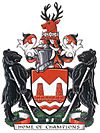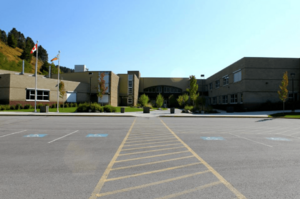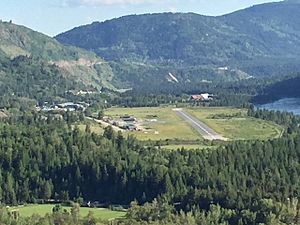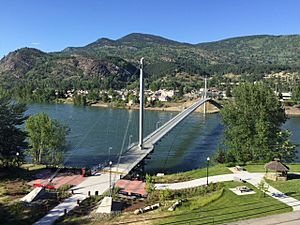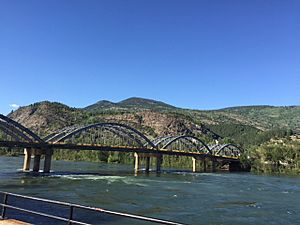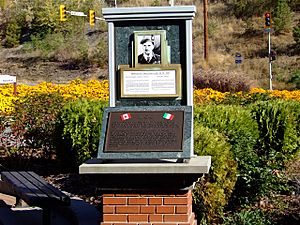Trail, British Columbia facts for kids
Quick facts for kids
Trail
Trail Creek
|
||
|---|---|---|
| City of Trail | ||
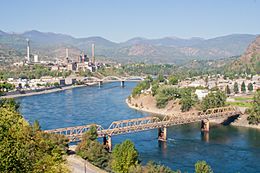 |
||
|
||
| Motto(s):
Explore Your Trail
|
||
| Country | Canada | |
| Province | British Columbia | |
| Region | Kootenays | |
| Regional district | Kootenay Boundary | |
| Government | ||
| • Type | Elected city council | |
| Area | ||
| • Total | 34.93 km2 (13.49 sq mi) | |
| Elevation | 440 m (1,440 ft) | |
| Population
(2023)
|
||
| • Total | 14,268 | |
| Time zone | UTC-8 (PST) | |
| Forward sortation area |
V1R
|
|
| Area code(s) | 250, 778, 236, 672 | |
| Highways | 3B 22 |
|
| Waterways | Columbia River | |
Trail is a city in the West Kootenay region of British Columbia, Canada. It's located in the interior of the province. The city got its name from the Dewdney Trail, a historic path that went through the area. It was first called Trail Creek, then shortened to Trail in 1897.
Contents
Geography and Climate in Trail
Trail covers an area of about 34.78 square kilometers. The city sits on both sides of the Columbia River. It is about 10 kilometers north of the United States border. The Columbia River valley here is surrounded by mountains. The Monashee Mountains are to the west, and the Selkirk Mountains are to the east.
The Columbia River flows north-south from Castlegar. It then turns east near downtown Trail. Finally, it reaches the Canada–United States border at Waneta.
Weather in Trail
Summers in Trail are usually hot and dry. Nights are cooler. Temperatures often go above 35 degrees Celsius in the afternoon. The average summer temperature is around 29 degrees Celsius. Thunderstorms are common in late spring and summer. They often move into the valley from the south.
In the fall, you might see thick river fog. This happens especially at night and in the morning. Cold air gets trapped above the warm river. Winters are mild to cold, with some snowfall. Nearby towns like Warfield and Rossland get more snow. This is because they are at higher elevations.
The Monashee Mountains are the first big mountain range east of the Coastal Mountains. They catch moisture from the Pacific Ocean. Because of this, areas west of Trail get more winter snow. The plants around Trail are still green, but they are drier than in other parts of the West Kootenay region.
People and Culture in Trail
In 2021, Trail had a population of 7,920 people. These people lived in 3,736 homes. This was a small increase from 7,709 people in 2016. The city has a population density of about 226.9 people per square kilometer.
Italian Heritage in Trail
Trail is well-known for its large Italian community. Many people in Trail have Italian ancestry. In 1951, about 16.2 percent of the population was Italian. By 2016, this number was about 17.8 percent. This shows a strong and lasting Italian influence in the city.
| Panethnic group |
2021 | 2016 | 2011 | 2006 | 2001 | 1996 | 1991 | |||||||
|---|---|---|---|---|---|---|---|---|---|---|---|---|---|---|
| Pop. | % | Pop. | % | Pop. | % | Pop. | % | Pop. | % | Pop. | % | Pop. | % | |
| European | 6,425 | 84.54% | 6,475 | 87.26% | 6,775 | 91.49% | 6,330 | 90.82% | 6,685 | 91.26% | 7,160 | 95.85% | 7,110 | 92.34% |
| Indigenous | 675 | 8.88% | 645 | 8.69% | 390 | 5.27% | 450 | 6.46% | 290 | 3.96% | 130 | 1.74% | 235 | 3.05% |
| South Asian | 255 | 3.36% | 45 | 0.61% | 0 | 0% | 15 | 0.22% | 100 | 1.37% | 65 | 0.87% | 60 | 0.78% |
| Southeast Asian | 95 | 1.25% | 65 | 0.88% | 15 | 0.2% | 65 | 0.93% | 70 | 0.96% | 45 | 0.6% | 135 | 1.75% |
| East Asian | 60 | 0.79% | 95 | 1.28% | 110 | 1.49% | 45 | 0.65% | 135 | 1.84% | 40 | 0.54% | 95 | 1.23% |
| African | 20 | 0.26% | 40 | 0.54% | 90 | 1.22% | 30 | 0.43% | 0 | 0% | 0 | 0% | 35 | 0.45% |
| Latin American | 15 | 0.2% | 30 | 0.4% | 0 | 0% | 10 | 0.14% | 30 | 0.41% | 10 | 0.13% | 10 | 0.13% |
| Middle Eastern | 0 | 0% | 0 | 0% | 15 | 0.2% | 25 | 0.36% | 20 | 0.27% | 0 | 0% | 20 | 0.26% |
| Other/Multiracial | 55 | 0.72% | 20 | 0.27% | 0 | 0% | 10 | 0.14% | 0 | 0% | 10 | 0.13% | N/A | N/A |
| Total responses | 7,600 | 95.96% | 7,420 | 96.25% | 7,405 | 96.41% | 6,970 | 96.31% | 7,325 | 96.7% | 7,470 | 97.06% | 7,700 | 97.23% |
| Total population | 7,920 | 100% | 7,709 | 100% | 7,681 | 100% | 7,237 | 100% | 7,575 | 100% | 7,696 | 100% | 7,919 | 100% |
| Note: Totals greater than 100% due to multiple origin responses | ||||||||||||||
Religious Groups in Trail
The 2021 census showed different religious groups in Trail. About 50.9% of people reported no religion. Christianity was followed by 45.5% of the population. Other religions like Sikhism, Hinduism, and Buddhism were also present.
Education and Jobs in Trail
Trail is home to the main office of the Kootenay Boundary Regional District. This is one of the city's important employers.
Schools in Trail
Trail is part of School District 20 Kootenay-Columbia. The schools in the city include:
- Glenmerry Elementary School (Grades K-7)
- J. Lloyd Crowe Secondary School (Grades 8-12)
- James L Webster Elementary School (Grades K-7)
- St. Michael's Catholic School (Grades K-7, independent)
- Kootenay-Columbia Learning Centre (Grades 6-12)
The school district works to improve schools and learning. A new J. Lloyd Crowe Secondary School was built. It opened in September 2009.
Job Skills in Trail
Trail has many people working in skilled trades. About 26% of people aged 45-64 have a trades certificate. This is higher than the provincial average of 14%. This is mainly because of Teck Resources. This company is a big employer in the area. Fewer people in Trail have a university degree compared to the rest of British Columbia. This shows that many jobs in Trail are in trades.
Economy of Trail
Teck Resources is the biggest employer in the region. It used to be called Cominco. About 1,800 people work there. The average age of a worker at Teck Resources in Trail is 47. Many workers will retire in the next 15 years. This means there will be new job openings. Younger, more technical workers will likely fill these roles.
Trail also has the largest hospital in the West Kootenay region.
Teck Cominco Smelter: A Major Industry
Trail is home to one of the world's largest lead and zinc smelters. A smelter is a factory that extracts metal from ore. This smelter is the biggest employer in Trail. It provides about 1,400 jobs. It has been running for over 100 years. Many families have worked there for generations. Teck Cominco became a very important part of Trail's economy and culture.
You can visit the Teck Cominco Interpretive Centre in downtown Trail. It shows the history of the smelter. It has displays, hands-on exhibits, and videos. You can even take a tour of the smelter. The tours show how the company monitors the environment.
History of the Smelter
In 1896, Fritz Augustus Heinze opened a smelter in Trail. It processed ore from Rossland. The plant grew quickly. However, the smoke from the smelter contained sulfur dioxide. This caused health problems for the area.
In 1898, the Canadian Pacific Railway (CP) bought the smelter. CP improved the plant. They used cheap coal and new electricity. They also built taller chimneys to send the smoke higher.
By 1901, the company started processing lead. In 1902, Trail opened the world's first commercial electrolytic refining process. This process made pure lead, copper, silver, and gold. In 1906, the Consolidated Mining and Smelting Company of Canada (CM&S) was formed. CP owned most of it.
By 1925, the plant was very large. It had many different sections for processing metals and making chemicals. It employed 2,100 men.
Environmental Efforts
By the end of World War I, the smelter's smoke caused a lot of damage to the environment. This led to a long legal case called the "Trail smelter arbitration." This case helped create the idea that "the polluter pays." This means companies that cause pollution should pay to clean it up.
In 1966, the company changed its name to Cominco. Over the years, the smelter spent millions of dollars to control pollution. By 2007, a program started to test and remove contaminated soil from yards. Teck provides money for this cleanup. The pollution is from older smelting methods used before 1997.
Trail's Role in the Manhattan Project
Trail played a part in the Manhattan Project. This was a secret project during World War II to build the atomic bomb. Cominco built and ran a special plant in Trail. This plant made "heavy water" from 1943 to 1956. Heavy water was used in nuclear research.
Fun Things to Do in Trail
Trail Memorial Centre & Sports Hall of Memories
The Trail Memorial Centre is a very important building in the city. It has the Trail & District Public Library. It's also home to the Trail Smoke Eaters hockey team. The centre also has the Trail Museum and the Sports Hall of Memories. It's a place for many local sports activities. This building has been a community hub for a long time. It was home to two world champion Smoke Eaters teams.
River Activities and Music at Gyro Park
Gyro Park is located in East Trail. During the summer, it hosts "Music in the Park." The Columbia River is also popular here. People enjoy the currents that flow between the rocks.
The Historic Gulch
"The Gulch" is a historic neighborhood in Trail. In the early 1900s, many Italian immigrants moved there. They gave the area its unique character. It was first called "Dublin Gulch." Later, it became known as "The Gulch." This was because many Italian families settled there.
The Gulch is a narrow valley. It has steep slopes on both sides. Early settlers built houses there. They also planted vegetable gardens. These gardens reminded them of their home country. The Gulch today has shops and the Terra Nova hotel.
Home of Champions
The Greater Trail Area is known as the Home of Champions. This name celebrates people from the area who have done great things. They might be champions in sports, industry, or life.
In 1995, Kootenay Savings Credit Union wanted to honor the community. They decided to build a monument. It was built in 1996 in downtown Trail. This monument honors the "Champions" of the Greater Trail area.
A group was formed to choose the people to be honored. The monument was dedicated on September 28, 1996. Forty-three champions were honored that day. So far, 89 people and groups have been added to the monument. The City of Trail manages this project. More people will be honored in the future. They will be recognized for their special contributions to the community.
Famous People from Trail
Many notable people have come from Trail, including:
- John Rogers Anderson, former chief of the Defence Staff
- Jason Bay, former MLB baseball player
- Lauren Bay, Canadian National Softball Team pitcher
- Adam Deadmarsh, former NHL player and Stanley Cup winner
- Dallas Drake, former NHL player and Stanley Cup winner
- Ray Ferraro, former NHL player and sports analyst
- Bruno Freschi, architect for Expo 86
- Robert Hampton Gray, a Canadian hero from WWII and Victoria Cross recipient
- Shawn Hook, a singer
- Shawn Horcoff, former NHL player and captain of the Edmonton Oilers
- Barret Jackman, former NHL player
- Kerrin Lee-Gartner, Olympic Gold Medalist in skiing (1992)
- Cesare Maniago, former NHL player
- Seth Martin, former NHL player
- Steve Tambellini, former NHL player and GM of the Edmonton Oilers
Images for kids
See also
 In Spanish: Trail (Columbia Británica) para niños
In Spanish: Trail (Columbia Británica) para niños


